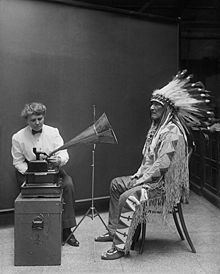
Back Klankopname en reproduksie Afrikaans تسجيل الصوت وإعادة إنتاجه Arabic Grabación y reproducción de soníu AST Mesin ngomong kenong-kenong BEW Enregistrament i reproducció del so Catalan تۆمارکردن و بەرھەمھێنانەوەی دەنگ CKB Záznam a reprodukce zvuku Czech Grabación y reproducción de sonido Spanish ضبط و بازتولید صدا Persian Gravación e reprodución de son Galician

Sound recording and reproduction is the electrical, mechanical, electronic, or digital inscription and re-creation of sound waves, such as spoken voice, singing, instrumental music, or sound effects. The two main classes of sound recording technology are analog recording and digital recording.
Acoustic analog recording is achieved by a microphone diaphragm that senses changes in atmospheric pressure caused by acoustic sound waves and records them as a mechanical representation of the sound waves on a medium such as a phonograph record (in which a stylus cuts grooves on a record). In magnetic tape recording, the sound waves vibrate the microphone diaphragm and are converted into a varying electric current, which is then converted to a varying magnetic field by an electromagnet, which makes a representation of the sound as magnetized areas on a plastic tape with a magnetic coating on it. Analog sound reproduction is the reverse process, with a larger loudspeaker diaphragm causing changes to atmospheric pressure to form acoustic sound waves.
Digital recording and reproduction converts the analog sound signal picked up by the microphone to a digital form by the process of sampling. This lets the audio data be stored and transmitted by a wider variety of media. Digital recording stores audio as a series of binary numbers (zeros and ones) representing samples of the amplitude of the audio signal at equal time intervals, at a sample rate high enough to convey all sounds capable of being heard. A digital audio signal must be reconverted to analog form during playback before it is amplified and connected to a loudspeaker to produce sound.